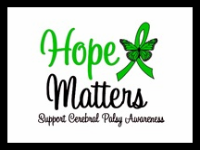Today is the official Cerebral Palsy Awareness Day...show your support and help disseminate knowledge! Wear something green if possible (picture below is DH wearing the only green T-Shirt he could find, which was his Official Volunteer Tee from the Tour de Cure to Beat Diabetes, LOL!).

If you have a blog, you can visit Life of Logan and participate in the prize giveaway!
Important info about Cerebral Palsy:
- The average prevalence of cerebral palsy is about 1 in 278 children. This first report of the prevalence and characteristics of CP, the most common cause of motor disability in childhood, are from Georgia, Alabama and Wisconsin. Can you even begin to imagine the numbers if there was a national surveillance?
- Cerebral palsy is one of the most common developmental disabilities in the US, affecting at least 800,000 children, adolescents and adults in America. Cerebral palsy is NOT a disease nor should it be considered one. It is not even a simple or single disorder but rather a broad range of disorders that disrupt a person’s ability to move, sit, stand, walk, talk and use their hands. The severity of the movement disorder and the type of movement difficulties can vary greatly. Some patients have only mild difficulties with balance, walking and fine motor skills while patients at the other extreme are completely trapped in their own bodies, fighting rigid limbs, and unable to speak or swallow.
- There is currently no cure for cerebral palsy and in most cases, it is not preventable. In over 50 years, treatments for CP have not progressed much at all. In fact, today, there remains little consensus among medical professionals regarding what causes CP or how best to treat it. Why do 800,000 or more Americans have CP, and yet we don’t know much more about what causes it or how to prevent it than we did a half century ago?
Resources: Centers for Disease Control (CDC) and Reaching for the Stars (RFTS)

1 comment:
Thank you a bazillion for your help spreading CP awareness! It means a lot to me and I appreciate you for helping!
BTW, your Emma is just darling!
Post a Comment